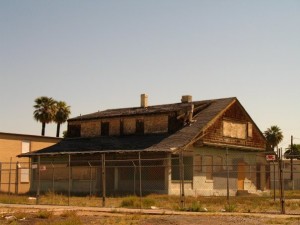Over the past two years, amidst all the new buildings popping up, Downtown Phoenix has quietly become a leader in promoting adaptive reuse. Adaptive reuse is the process of tailoring old structures for purposes other than those initially intended. As old buildings outlive their original purposes, adaptive reuse offers a process to modify these buildings for new uses while retaining their historic features. As a result, an old warehouse may become an apartment building, or a rundown church may find new life as a restaurant.

A prime candidate for adaptive reuse: the city-owned (ca. 1909) Leighton G. Knipe House at 1025 N. 2nd Street.
By taking buildings that are either historical, dated or in older, established areas of the city and ensuring their presence long into the future, adaptive reuse is one of the ultimate expressions of sustainability. Not only does this take advantage of materials that are already there (which is environmental and economical), but it also respects a city’s history and plays an important role in community revitalization. Adaptive reuse also demonstrates that old buildings make great places for new ideas. As the famous urbanist Jane Jacobs said, “Old ideas can use new buildings, but new ideas need old buildings.”
The city’s Adaptive Reuse Program began as a pilot program in April 2008 to streamline the process of modifying older buildings for new business uses. In addition to adopting the International Existing Building Code, the city offers guidance, expedited time frames and reduced costs to individuals and companies looking to “recycle” older buildings for new business uses. Program participants can save between two weeks to three months time and $2,000 to $40,000 during the development process. In September 2009, the program won a “Crescordia” in the “Livable Communities” category at Valley Forward’s Environmental Excellence Awards. The Crescordia, named for a Greek term meaning “to grow in harmony,” is the highest honor awarded in each category.
This issue is important to the city, because as Mark Leonard, Director of the Phoenix Development Services Department explains, “Adaptive reuse preserves our history, helps small business owners be successful, creates unique restaurant and business settings for all of us to experience and it’s environmentally friendly.” Mayor Gordon concurs, noting in a 2008 speech, “Historic buildings are a critical part of what makes the Phoenix skyline truly our own, truly unique.”

The interior of The Lost Leaf
One example of adaptive reuse that will be familiar to many DPJ readers is modifying a historic, single-family residence for use as a restaurant or business. Some notable participants in the program include Tuck Shop (2245 N. 12th St. in Coronado), The Lost Leaf (914 N. 5th St. in Evans Churchill), The Paisley Violin (1030 NW Grand Ave.) and Hula’s Modern Tiki (4700 N. Central Ave. in Uptown). In total, the program has supported 30 total adaptive reuse projects in the past 18 months, although a few of them did not proceed past plan review due to the economy.
Earlier this month, based on the recommendations of a Development Services Ad Hoc Task Force, council unanimously approved expanding the Adaptive Reuse Program. During its deliberations, the task force looked at the existing program’s experience to date, as well as best practices from other cities, and came up with what may be the most comprehensive adaptive reuse plan in the country.
The expanded plan now includes buildings constructed prior to the year 2000, increases the size limits from 5,000 square feet to 100,000 square feet and allows for occupancy change flexibility. This expansion of the program provided increased opportunities to rezone, reuse and revitalize vacant strip malls, big box centers and other blighted community areas and keep them out of the landfill.
Special thanks to Jim McPherson (Arizona Preservation Foundation), Kimber Lanning (Local First AZ) and Denee McKinley (City of Phoenix Office of Customer Advocacy) for their assistance in researching this article.







Good ideas, except Phoenix doesn’t have much history. I’m all for using what we already have, as long as it’s cheaper and quicker to build. There’s no sense in preserving a building SOLELY because it’s old, and that seems to happen a lot around here.
From an eco-friendly standpoint, there’s a lot of sense in preserving existing buildings.
“Phoenix doesn’t have much history.”
That statement is amazingly ignorant.
Phoenix had a ton of history and it was all torn down because of that mentality. Phoenix had a bustling downtown. Any and every building that can be preserved, should be for any reason.
Actually Mr. Hurst, Phoenix has a lot of history. Check it out as it dates from early 1000 or so AD. You just need to be more cognizant of the fact that the formal origins of Phoenix date from the late 1860s. Not long in comparison to the East Coast, but it is OUR history. I find it sad that it took the city so long to be supportive of people who wanted to find new uses for old buildings. It reminds me of how at one point people used to remake clothing into new apparel. And “leftovers” became parts of quilts. Architects of our older buildings were much more aware of siting buildings to maximize shade and minimize the brutal rays of the sun. So it does become more economical to consider a number of factors along with age in deciding whether a building merits reuse. I agree that not all old buildings should be saved, but those are often the ones that were poorly built or designed in the first place. And cheaper & quicker is what has caused us to be a disposable society. I frankly like my things to last as long as possible and that includes my buildings (I love my late 1923 poured in place concrete home!).
For the record, the City never assisted The Lost Leaf in anyway, In fact it took us 14 months for them to even look at the interior of my building.. This program was not available at the time. Mar 2006 – May 2007. So for the record The Lost Leaf spent 100% of our own time and money battling the City for 14 months to open losing tens of thousands of dollars in the process. I am aware our scenario was more complicated, but the commercial C of O process is the same non the less. Getting a State liquor license was a very simple process compared to trying to open a legitimate business in an old house.
I am aware that things have changed for the better at COP helping these adaptive reuse programs. Kudos, to COP and Mayor Gordon for helping businesses who are spending their own funds to reuse these buildings.
We won’t have any history if we keep tearing buildings down before they reach historical status. It seems that once buildings hit a 50 year mark here they want to tear them down.